What to Use
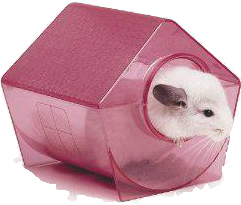 A plastic bath house can be
A plastic bath house can bepurchased at most pet stores.
Proper dust is not the only thing needed to bathe chinchillas. A chinchilla duster is necessary. The dusters that ranchers use is typically a metal box that is open on one side. Dust is placed in the bottom of the duster which is then put into the chinchilla’s cage. Other items can be used in place of the metal duster. Some suggestions include a plastic shoe box, a one gallon glass fish bowl, or a one gallon pickle jar. Store bought, house shaped, plastic dusters are available and are fine for use. Never leave a plastic duster in the cage for more than the time it takes the chinchilla to bathe. If the chinchilla chews on the plastic and swallows some, it could cause a blockage in the chinchilla’s intestines. This could be deadly. Some stores sell ceramic dusters which look like cute little animals. They are not recommended since even the largest of these are too small for an adult chinchilla to properly bathe.
How to Give the Bath
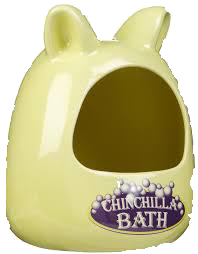 This ceramic house is too small
This ceramic house is too smallfor a chinchilla to properly bathe.
Frequency of Bathing
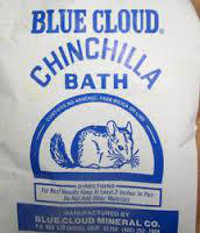 A 50 pound bag of the most
A 50 pound bag of the mostrecommended brand of dust
for bathing chinchillas.
Cleanup
Cleanup is quite simple. Just remove the bath house from the cage, sift the dust or throw it away if the chinchilla has urinated in it. After half an hour or so, wipe any dust off of the shelves or bottom of the cage. Some people put the bath house and chinchilla in a dry, empty bathtub. Once the chinchilla is finished, simply remove the house and chinchilla, and rinse out the tub. If this method is used, the chinchilla should be supervised while it is bathing.
Alternatives/Allergies
Some chinchilla owners find that they are allergic to the chinchilla dust. Substituting other material for the dust may relieve the allergy symptoms. Cornstarch and has been used with some success. Another alternative is a product used to keep horse stalls smelling good. It is called Sweet PDZ and is available at most feed or farm supply stores. Each of these items should be used in the same manner as the regular dust. Note: ash from a fireplace or barbeque and talcum powder should never be used to bathe a chinchilla.
Over Dusting
It is possible to bathe a chinchilla too frequently. When this happens the chinchilla’s skin will become dry and itchy. The chinchilla will be seen constantly scratching itself. The ears and feet will become dry. Dry ears look irritated and often have small bumps on them. Dry feet can crack and bleed. If these things happen, the chinchilla needs to take fewer baths than it was receiving.
New Mother and Kits
When a female chinchilla gives birth, she can get quite messy. Chinchillas eat the afterbirth to get nutrients from it and to hide evidence of the birth. This can cause some parts of the mother to be covered in blood. Once she is done with the birth, allow her to clean herself and the babies. Once everyone is dry, offer the mother a dust bath. The kits can remain in the cage for the first few baths. Once the kits can get around fairly well, allow them to join their mother in the bath. Make sure that the bath is big enough for the mother to roll around without crushing her babies beneath her. The kits may just sit in a corner and watch their mother for a few weeks. This is fine; just keep offering the bath. Eventually, the little ones will figure out what they need to do.
Water Baths
Under normal circumstances, a chinchilla should not need to take a water bath. Conditions which could cause a need for a water bath include syringe food or medicine matted into the fur, urinary incontinence, severe diarrhea and the chinchilla getting something sticky or oily in its fur that will not come out or will be made worse with a dust bath.
To bathe the chinchilla, begin by gathering the necessary items. These should include at least one towel, a mild shampoo such as baby shampoo, a container, and a blow dryer. Fill the sink or a large bowl with warm water and place the chinchilla in it. Do not let go of the chinchilla. Instead, hold the chinchilla so that its head is out of the water with one hand while you bathe the chinchilla with the other. Make sure that the chinchilla is wet before adding the shampoo. Only a small amount is needed since chinchillas are relatively small. Start with just a couple of drops and increase if necessary. Gently work the shampoo into the fur and massage it into a nice lather. Rinse with warm water using the container to carefully pour water over the chinchilla. Do not pour any water or shampoo over the chinchilla’s head and face. Once thoroughly rinsed, use the towel to dry the chinchilla. Once towel dried, take the blow dryer and set it on the lowest setting. Blow dry the chinchilla until it is completely dry from the skin out. Once dry, the chinchilla can be allowed to go back in its cage. Keep in mind that any moisture left in the fur can cause fungus (ringworm) to grow in the fur and on the skin.
Injuries
When a chinchilla is injured or has had surgery, care must be taken to keep the wound clean. For this reason, it is best to wait until the entire site has scabbed over before allowing the chinchilla to bathe. This, along with keeping the cage clean, will help keep the wound from becoming infected.


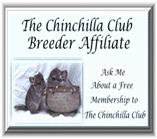
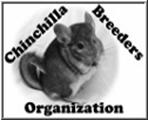 Site Last Updated on December 31, 1969 05:00 pm
Site Last Updated on December 31, 1969 05:00 pm